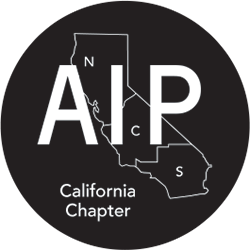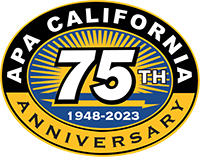Planning provides a vision for communities today and in the future. The goal of planning is to maximize the health, safety, and economic well-being of all people living in our communities: how we move around our community, how we build economic health and social equity, where we want to live, and how we enjoy recreation and nature.
- Adapted from the American Planning Association website

California is a state of possibilities -- extraordinary environments, vibrant cities, dramatic coastlines, green forests, expansive deserts. But it is also a state in the throes of constant social, economic, and environmental change: every aspect of the state’s being, good and bad, is a function of how humans have interacted with the land they inherited to create the places we know today. The communities we have built reflect the choices we have made about how we use our land, build our housing, build and maintain transportation and other infrastructure, rest and recreate, and protect critical environmental and historic resources.
On January 1, 1948, a new statewide organization was formed with the intention of building better communities through sound urban planning at the local, regional and state levels. Known then as California Chapter of the American Institute of Planners (CCAIP), over the past 75 years that small group of about 100 planning officials has evolved into APA California, a statewide organization with 5,000 members, the largest statewide organization focused on building better, healthier, more equitable and pleasing communities through good planning.

Planners are typically (but not necessarily) individuals trained in building communities, whether they be urban, suburban or rural environments. They may come from a variety of backgrounds including physical design (architecture, landscape architecture, urban design and art), public and environmental policy, land use, law, housing, transportation, community engagement, public administration, and others.
They may be degreed professionals, lay planners serving on appointive bodies, activists, elected officials, academicians, and/or students. Most professional planners have either a bachelor’s or master’s degree in Urban and Regional Planning, a field that has seen explosive growth over the past seven decades.
While most planners work for public agencies – cities, counties, regional and state governments – many others work in the private sector, designing for private firms or offering planning services to those who need them. Still others work for non-profit entities specializing in community engagement, equity, and community-building. They may work in specialty fields such as historic preservation, or in policy institutes that study community change. Increasingly, planners focus on questions of environmental., social and economic equity as part of their community-building efforts, seeking to partner with, rather than plan for, communities.
APA California today is the largest of 48 chapters in its parent organization, the American Planning Association. APA California is a 501(c)6 organization.
More than 5,000 members strong, APA California is a network of practicing planners, citizens and elected officials committed to urban, suburban, regional and rural planning in California. APA California offers a spectrum of benefits including information, services and support to advance planning. While most members are planners, lay planners or community leaders, anybody interested in the future of cities can join APA.
APA California represents the planning movement in discussions in Sacramento concerning changes in the multitude of laws that are introduced each year to address critical growth, planning and environmental issues. The national organization partners with other organizations to advocate in Congress concerning the needs of American cities, counties and regions.
During its 50th anniversary year in 1998, APA California partnered with California State University, Northridge (CSUN) to establish and host APA California’s archives. That collection has grown to more than 250 boxes of material including organizational documents, planning legislation, reports concerning the planning profession, landmark planning documents from California cities and counties, and a host of other materials.
This digital exhibition – the first such exhibit for APA California – has been designed and created by the University Library’s web services team at CSUN to tell the story of California planning as seen through the lens of APA California over seven decades. Many of the exhibits in this digital presentation are drawn from the archives themselves. Come join us as we explore seven decades of California planning.
This exhibit is not a comprehensive history of urban planning in California – although the collection includes a wide variety of artifacts -- but principally reflects on APA California’s role over the past 75 years in promoting effective urban planning by highlighting pioneering planners, planning landmarks, and issues.
